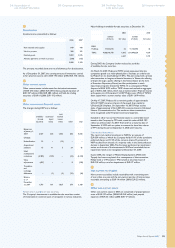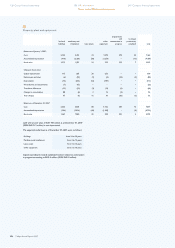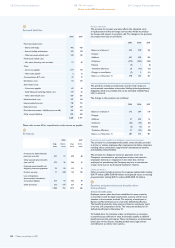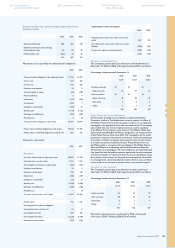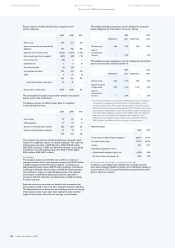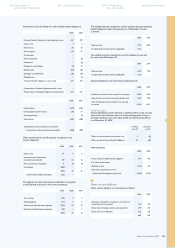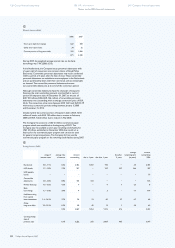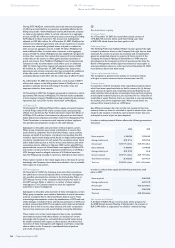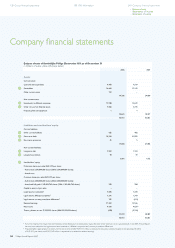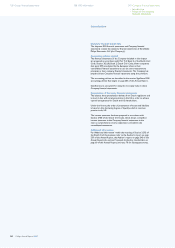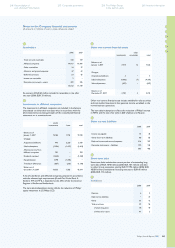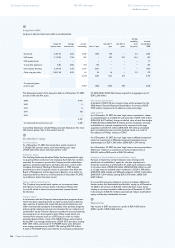Philips 2007 Annual Report Download - page 228
Download and view the complete annual report
Please find page 228 of the 2007 Philips annual report below. You can navigate through the pages in the report by either clicking on the pages listed below, or by using the keyword search tool below to find specific information within the annual report.
Philips Annual Report 2007234
62
Contingent liabilities
Guarantees
Philips’ policy is to provide only guarantees and other letters of support,
in writing.
Philips does not stand by other forms of support. At the end
of 2007, the total fair value of guarantees was EUR 3 million (2006: EUR
4 million). The following table outlines the total outstanding off-balance
sheet credit-related guarantees and business-related guarantees provided
by Philips for the benet of unconsolidated companies and third parties
as at December 31, 2007.
Expiration per period
in millions of euros
business-
related
guarantees
credit-related
guarantees total
2007
Total amounts committed 432 45 477
Less than 1 year 142 5 147
2-5 years 95 16 111
After 5 years 195 24 219
2006
Total amounts committed 466 42 508
Less than 1 year 151 14 165
2-5 years 80 2 82
After 5 years 235 26 261
Environmental remediation
The Company and its subsidiaries are subject to environmental laws
and regulations. Under these laws, the Company and/or its subsidiaries
may be required to remediate the effects of the release or disposal of
certain chemicals on the environment.
In the United States, subsidiaries of the Company have been named as
potentially responsible parties in state and federal proceedings for the
clean-up of various sites. The Company accrues for losses associated
with environmental obligations when such losses are probable and
reliably estimatable.
Legal proceedings
The Company and certain of its (former) group companies are
involved as a party in legal proceedings, including regulatory and other
governmental proceedings, relating to such matters as competition
issues, commercial transactions, product liability, participations and
environmental pollution. In respect of antitrust laws, the Company and
certain of its (former) group companies are involved in investigations
by competition law authorities in several jurisdictions and are engaged
in litigation in this respect. Since the ultimate disposition of asserted
claims and proceedings and investigations cannot be predicted with
certainty, an adverse outcome could have a material adverse effect
on the Company’s consolidated nancial position and consolidated
results of operations for a particular period.
Provided below are disclosures of the more signicant cases:
Asbestos
Judicial proceedings have been brought in the United States, relating
primarily to the activities of a subsidiary prior to 1981, involving
allegations of personal injury from alleged asbestos exposure.
The claims generally relate to asbestos used in the manufacture of
unrelated companies’ products in the United States and frequently
involve claims for substantial compensatory and punitive damages.
The subsidiary’s businesses which allegedly gave rise to these alleged
liabilities were completely sold in 1984 and the subsidiary’s ongoing
operations are not material to its parent or the Company.
At December 31, 2007, there were 5,084 cases pending, representing
9,906 claimants (compared to 4,370 cases pending, representing 9,020
claimants, at December 31, 2006 and 3,984 cases pending, representing
8,082 claimants, at December 31, 2005). Most of the claims are
in cases involving a number of defendants. During 2007, 1,656 cases,
representing 2,413 claimants, were served against the Company’s
subsidiaries (1,140 cases, representing 2,930 claimants, were served
in 2006 and 2,052 cases, representing 3,283 claimants, were served in
2005). While management believes there are meritorious defenses
to these claims, certain of these cases were settled by the subsidiaries
for amounts considered reasonable given the facts and circumstances
of each case. A number of other cases have been dismissed with no
payment. During 2007, 942 cases, representing 1,527 claimants,
were settled or dismissed (754 cases, representing 1,992 claimants,
were settled in 2006 and 977 cases, representing 1,229 claimants,
were settled in 2005).
In addition to the pending cases discussed above, a subsidiary of the
Company was one of approximately 160 defendants initially named in
a case led in August 1995 in Morris County, Texas. Since the time the
case was brought in 1995, the subsidiary had not been involved in any
substantive activity in the case other than ling an answer to the
complaint and had no information concerning the types of alleged
diseases or injuries involved. Commencing in the fourth quarter of
2005 and continuing thereafter, plaintiffs’ counsel in this matter led
information concerning the claimants and their alleged diseases with
the Court. The claims have now been severed into ve cases: two cases
with an aggregate of 282 malignant disease claims; two cases with an
aggregate of 223 nonmalignant disease claims with alleged impairment;
and one case with 3,177 claims that have no impairment at this time.
The cases with the malignant disease claims and nonmalignant disease
claims with alleged impairment are currently pending in Morris County.
The case containing the claims that have no impairment at this time
has been transferred to Harris County, Texas.
In accordance with IAS 37, an accrual for loss contingencies is recorded
when the Company has incurred an obligation based upon a past event,
if it is probable an outow of resources will be required to settle the
obligation, and a reliable estimate of the obligation can be made. Prior
to 2006, this subsidiary established an accrual for loss contingencies
with respect to asserted claims for asbestos product liability based
upon its recent settlement experience of similar types of claims, taking
into consideration the alleged illnesses in pending cases.
An accrual for loss contingencies with respect to unasserted claims
for asbestos product liability was not established prior to 2006 since
the Company, with the assistance of ARPC, a rm with substantial
experience in valuing and forecasting asbestos liabilities, concluded
it could not reliably estimate this liability in accordance with IAS 37
due to the subsidiary’s historical claims experience coupled with the
uncertainties surrounding pending and ongoing asbestos litigation
and legislative reform efforts both at the federal and state levels.
During 2006, ARPC reviewed the subsidiary’s history of, among other
things, claims and diseases alleged, and claims settled or dismissed in
order to provide the subsidiary with an estimate of the volume, timing
and cost of both current and future asbestos-related personal
injury claims. In light of additional claims history experienced by the
subsidiary, as well as the impact of state tort reform in several states,
the clarication of the possibility of national legislation and other
factors, ARPC was able to use a conventional methodology for
estimating future asbestos-related personal injury claims to provide
a projection of the subsidiary’s liability for pending and unasserted
potential future asbestos-related claims for the period from 2006
through 2016 (“the Study”). As a result of the inherent uncertainties
involved in long-term forecasts, the Company concluded that it did
not believe it could reliably forecast indemnity costs that might be
incurred for claims asserted after 2016.
The methodology used in the Study to project the subsidiary’s total
liability for pending and unasserted potential future asbestos-related
claims relied upon various assumptions and factors, including
the following:
An analysis of the subsidiary’s pending cases, by type of injury, •
and an allocation of unknown injuries based on the empirical
experience of the subsidiary;
An analysis of data generated from a conventional model used to •
project future asbestos claims for mesothelioma and lung cancer;
An analysis of the correlations between lung cancer ling rates •
and the rates for other cancers and non-malignancy claims;
Epidemiological studies estimating the number of people likely •
to have developed asbestos related diseases;
An analysis of average claim payment rates and mean payment •
amounts by injury for claims closed in 2005 and 2006;
An analysis of the period over which the subsidiary has resolved and •
is likely to resolve asbestos-related claims against it in the future; and
An assumed ination rate of 2.5%, reduced by 1.5% to reect lower •
claim valuations due to the aging of the claimant population.
128 Group nancial statements 188 IFRS information
Notes to the IFRS nancial statements
240 Company nancial statements



